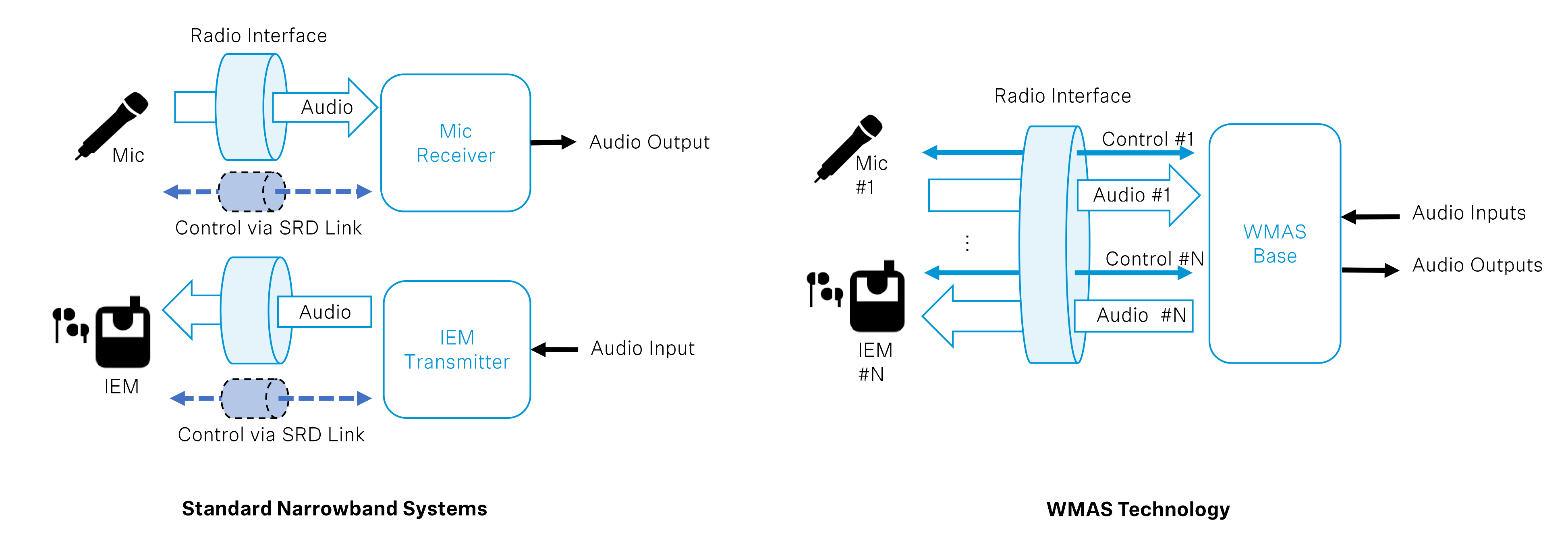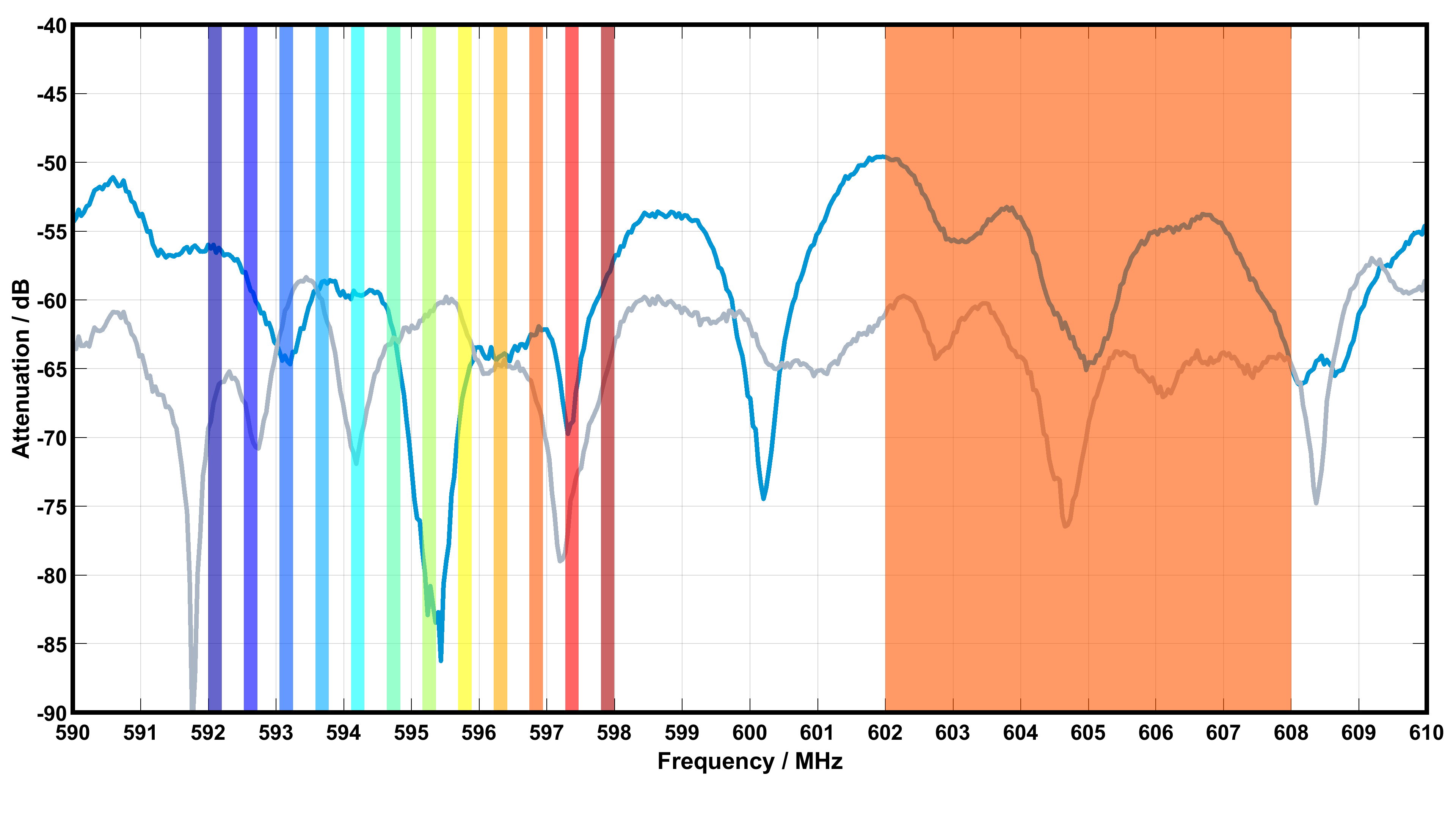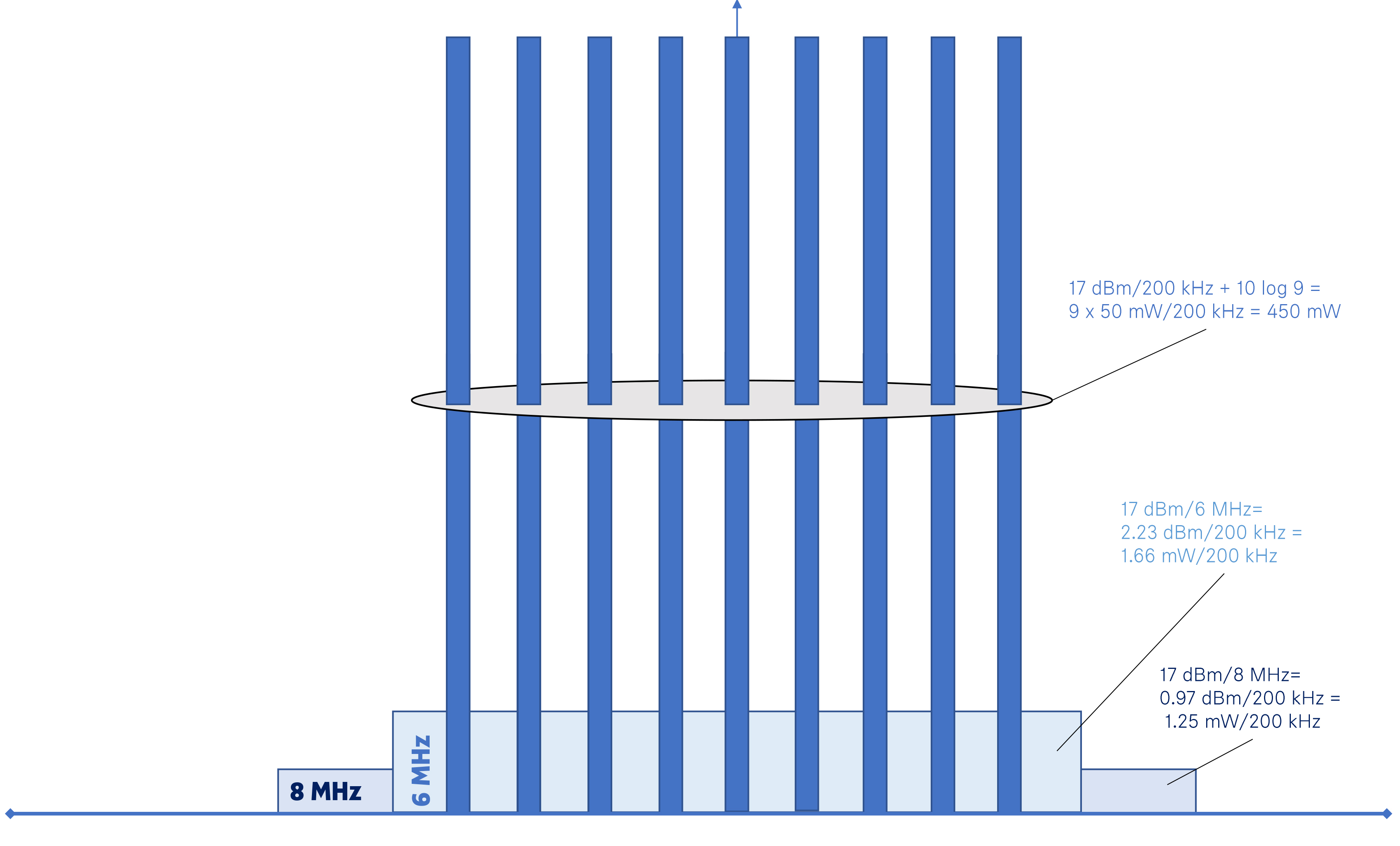Technical Paper
Insights into Frequency Coordination of Broadband Wireless Multi-Channel Audio Systems (WMAS) and Narrowband Wireless Equipment
By Dr Andreas Wilzeck

Introduction
The radio spectrum used for wireless microphones and wireless in-ear monitoring systems is generally a shared resource. These professional audio applications share the same spectrum with various other radio services and users, such as broadcasting, radio astronomy, and military. The TV-UHF spectrum available to professional wireless mics and monitors varies considerably from one location to the other depending on local broadcasting services and other applications. While frequency spectrum sharing is defined and overseen by national regulatory authorities, the coordination of radio frequencies that are to be used at an event or a venue is done in the mutual interest of all wireless equipment users on site, who need to rely on interference-free operation of their devices and tools.
Usually, an expert, sometimes with the support of a team, takes over the task of frequency coordination from the organizer of an event or the operator of, for example, a theatre. This expert, who is usually called a “frequency coordinator” or RF manager, is the central person in all frequency matters concerning an event or venue. Their role is to communicate, supervise and manage all frequency-related matters. They collect requests from all users, plan and calculate the frequencies to be used, assign the frequency resources to the users, monitor interference levels, manage any cases of interference, and troubleshoot and supervise all frequency uses before and during an event.
The frequency coordinator works hand in hand with the sound engineers who take care of all sound-related issues. Sound engineers handle the setup, the soundcheck, and the front-of-house and monitor mixing of live sound including effects for concerts, corporate events, theatres, and sporting events.
Notably, events are getting larger and more complex, but the available radio spectrum for wireless microphones and in-ear monitors has been shrinking due to regulatory decisions. Today, a frequency coordinator must deal with a much greater demand while fewer resources are available and more interference from adjacent bands can occur. For example, the use of cellular mobile radio in neighbouring frequency ranges can be quite close to coordinated wireless microphone and IEM links as far as spatial distance and frequency separation are concerned.
Compared to an open-air festival, frequency planning for indoor use – for example in theatres, broadcasting facilities or music clubs – is much easier to handle because the building itself will provide some protection and attenuation, and the RF environment is more controllable than outdoors. When coordinating frequencies for a broadcasting studio, for example, it is more about stable frequency planning for the different studios and the wireless applications involved on site. A temporary festival or event, on the other hand, has to deal with frequency assignments for many different users that come together for this one event and may have divergent interests.
In both situations, the frequency coordinator has to deal with interference products caused by other equipment that is important for production, for example video signal converters or video/light signal distribution (splitters and combiners).
Where we come from – shrinking radio spectrum resources are a troublemaker for large events and installations
In the European Union, the potentially available TV-UHF band resources below 1 GHz shrank from 392 MHz to 233 MHz (including the 800 MHz duplex gap) due to digital dividends I and II. For professional wireless audio devices, just 59.4 % of the resources remain. Actually, this percentage is lower, as all broadcast stations that operated in the 700 and 800 MHz range were also moved to 470-694 MHz, and are packed much more tightly now as a consequence. The available TV-UHF spectrum varies considerably from location to location, especially when you are close to country borders – here, only very few TV channels are vacant. There is a risk that the scarce resources in TV-UHF might be reduced further due to national regulatory decisions after the World Radio Conference 2023 (WRC-23).
In the USA, only the frequency range between 470 and 608 MHz remains, so only 138 MHz. As a result, some major cities have no vacant TV channel for professional wireless audio equipment to operate in. The FCC grants organizers of major events and mega-events Special Temporary Authority to handle their equipment in “frequency bands of the past” that are not yet used by cellular mobile.
The introduction of digital wireless microphones provided limited relief as they allow simplification in frequency planning and a denser frequency deployment by equidistant placement of wireless links. A true solution for handling the growth in demand and complexity of events and productions is still missing.
Overall, the growing radio spectrum demand calls for further efficiency gains, additional suitable frequency ranges, and more coordination efforts, especially for large events and mega-events.
WMAS – the RF game changer for professional wireless audio applications at large events, mega-events, and installations
With its implementation of a Wireless Multi-channel Audio System (WMAS), Sennheiser is re-thinking wireless audio transmission at live events, theatres, and broadcast studios – basically wherever many audio channels are up in the air. WMAS is essentially a bidirectional wireless broadband technology that combines microphones, in-ears, and remote control in just one broadband RF channel. This entails significant efficiencies in spectrum use – not just by technology, but also by enabling workflow improvements.

Sennheiser’s radio implementation of WMAS is based on Orthogonal Frequency Division Modulation (OFDM), Time Division Duplex (TDD) and Time Division Multiple Access (TDMA).
The digital transmission technique employed is OFDM combined with channel coding which allows the frequency diversity of the wireless RF channel to be exploited. More diversity exploited makes transmission more reliable, no matter if it is indoors or outdoors.
TDD enables bidirectional transmission by having a certain period for receiving and another period for transmitting. The duration of both periods can be adjusted, meaning that you can have all microphone, all IEM or any mix of them.
TDMA divides these transmit and receive periods into dedicated time slots. A WMAS device can be allocated one or multiple time slots. You could say that dedicated time slots are the fundamental resource in WMAS, as compared to the dedicated frequencies of narrowband transmission links. Each WMAS device speaks up (transmits) in its dedicated time slot(s) and is silent during the other ones. Each device knows when to listen (receive). None of the devices speak at the same time, so each device enjoys the full RF channel bandwidth on its own, albeit for a short time.
From the point of view of frequency coordination, a WMAS system will employ the same frequencies as today’s narrowband systems. However, IEMs and microphones, which are split between two RF ranges that are several MHz apart today, can now be handled together in a single TV channel and can be integrated into one belt pack. Just one antenna is required.
Instead of today’s typical spatial diversity with two antennas, WMAS will offer 30-fold diversity in a 6 MHz TV channel or 40-fold diversity in an 8 MHz TV channel with this single antenna. The gain in diversity is available for all receiving devices, so that combined, bidirectional bodypacks including low-latency, true digital in-ear monitoring would also benefit.
The use of multiple antennas is possible, but with different motivation, namely redundancy, coverage extension, and serving additional frequency bands – WMAS has different versions for operation in the TV-UHF range and in the 1350 MHz to 1525 MHz range.
The system operates with a total transmit power of up to 50 mW – basically the power of a single narrowband microphone today – which is spread over a 6 MHz or 8 MHz-wide RF channel. Within the capacity limit of the system, there will no longer be any scaling of the total transmit power by the number of devices used.

WMAS uses dedicated time slots for each WMAS device
(on the right-hand side: one device using the full RF bandwidth on its own)
Extensive frequency planning will not be required, except for selecting a single RF channel within a TV-UHF channel. Within these 6 or 8 MHz, users could deploy 16, 32, or even more audio channels of arbitrary direction. The frequency coordinator would assign a 6 MHz or 8 MHz block with a centre frequency to the sound engineer for deploying a WMAS. The coordinator would also determine the best places to put the system’s antenna (or antennas for range extension).
Within the WMAS, the sound engineer would be able to flexibly select the audio quality, latency, range, and resource occupation for every single audio transmission from and to the devices involved. The sound engineer can arrange and change the audio resources assigned to these devices as and when required. A single base station is able to process 64 audio channels (32 inputs and 32 outputs for interfacing) in one 19”/1U rack unit.
WMAS would provide digital quality sound and make frequency coordination easier.
Co-existence of narrowband technology and WMAS – More details about WMAS technology
Narrowband systems and broadband WMAS will co-exist in the field, and WMAS will employ the same frequencies that today’s narrowband systems operate on. In wireless technology, co-existence describes the operation of different equipment, technologies, and uses in one frequency range without harming the operation of each other. Frequency coordination basically organizes the co-existence at a venue or a temporary location. In coordinating narrowband solutions and WMAS, all well-established methods for frequency coordination will remain in place, but WMAS will make coordination easier and faster.
The WMAS technology has certain features that facilitate co-existence, first and foremost its bidirectional nature. Let us take a closer look.
According to ETSI TR 103 450, a WMAS consists of a WMAS base station and mobile WMAS devices, for example a handheld, a bodypack, or devices with any other form factor.
With WMAS technology, all devices need to be transceivers as they must be able to transmit and receive control information to organize and synchronize the whole system. A WMAS device can be an audio transmitter, an audio receiver, or both. Audio transmitting and receiving can be for one or more audio channels. A WMAS device that is capable of being an audio transmitter and a dual-channel audio receiver does not need to do both – it depends on how the sound engineer has configured the device.
A WMAS base station is able to scan the RF spectrum, so that the operator can see what is on air without the need for any additional equipment. The operator selects the single WMAS carrier frequency that was assigned to them from the frequency coordinator and turns on the RF.
WMAS devices must be paired with, connected to, and configured on a WMAS base station before they transmit. There is no more risk of unintended transmission due to old or pre-set RF configurations.
A WMAS device that loses its connection to the WMAS base station will stop transmitting after a certain time and seek to re-establish connection. This eliminates the risk of interference from transmitters that are live unintentionally, for example when performers are wandering through the venue or event site for a chat or a need.
The fact that a WMAS operates with low spectral density and low transmit power is key for good co-existence and for WMAS to be a “good neighbour” in a populated radio spectrum. It reduces the required separation distances and allows much denser deployments at, for example, multi-stage festivals and installations in venues and studios. The re-use of frequencies still requires some planning effort, but the adjustable transmit power will facilitate advanced site and frequency planning.
If users violate the coordinated frequency plan, co-channel operation of narrowband and WMAS can happen. Let us take a closer look at this scenario. A 200 kHz narrowband receiver will receive only a small fraction (1/30 or 1/40, depending on whether the TV channel is 6 or 8 MHz wide) of the emissions from a WMAS. On the other hand, the full emissions of a 200 kHz narrowband transmitter would fall into the receiver bandwidth of a WMAS device.
Let’s assume a narrowband 200 kHz microphone link with 50 mW / 200 kHz is accidentally co-operated in an 8 MHz WMAS channel. The narrowband receiver will be exposed to an interference power of less than 1.25 mW in its 200 kHz receiver bandwidth, neglecting propagation losses. By comparison, an 8 MHz WMAS receiver will see an interference level of 50 mW, again neglecting propagation losses. Just to emphasize this: We are considering a single narrowband microphone co-channel to a multi-channel audio system, which can have 16, 32 or even more channels.

As always with digital transmission, in both cases the ratio of received signal to noise will determine whether the interference is harmful or not. Thoughtful system design, exploitation of frequency diversity, and advanced signal processing give a WMAS solution the robustness to continue operation even when such narrowband interference appears in its vicinity.
While it is recommended that the same minimum guard distance as with narrowband systems is kept, the WMAS system proved to be extraordinarily robust during a practical test at the Sennheiser premises where it was sandwiched between a TV channel with analogue IEM links and a TV channel with several digital microphone links.
The Sennheiser implementation of WMAS has each WMAS device (handheld, bodypack, or antenna) contributing to distributed interference sensing during operation, so that the interference level of each device is always known to the operator. This enables the operator to see what is happening and take informed decisions for action. As today, the focus would be on finding and eliminating the source(s) of interference. If this is not possible, the WMAS operator might opt to switch to another broadband channel. This will only cause a short interruption as all devices are fully controlled by the base station.


